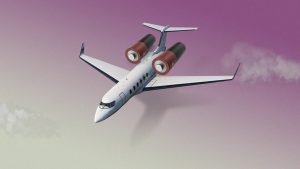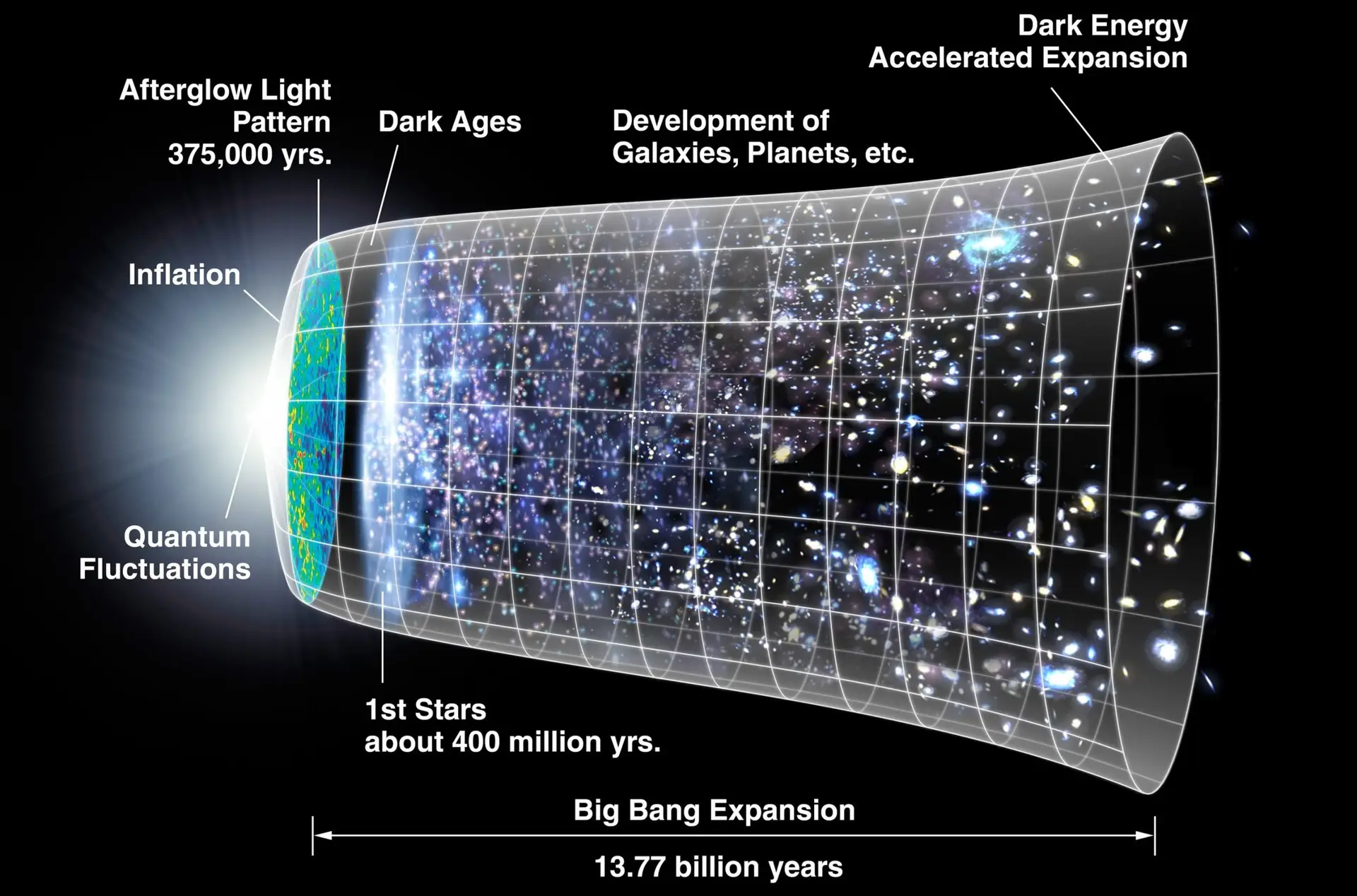
(Wiki Image).
AI Airplane Invention 2050-2250
Here are some potential top inventions in airplanes between 2050 and 2250:
#1. Electric airplanes
Electric airplanes could revolutionize air travel by making it more environmentally friendly and sustainable. Electric airplanes would not produce any emissions, which would help to reduce air pollution and greenhouse gas emissions. Electric airplanes would also be quieter than traditional airplanes, which would make them more pleasant to fly in and to live near.
#2. Supersonic airplanes
Supersonic airplanes could make air travel much faster. Supersonic airplanes could travel at speeds of Mach 5 or higher, which would mean that a flight from New York to London could take as little as an hour. Supersonic airplanes would be expensive to operate, but they could be used for business travel and for transporting goods and people quickly over long distances.
#3. Vertical takeoff and landing (VTOL) airplanes
VTOL airplanes could make air travel more convenient by allowing airplanes to take off and land vertically. VTOL airplanes would not need long runways, so they could be used to land in more places, such as city centers and small airports. VTOL airplanes could also be used for air taxis and for emergency evacuation.
#4. Self-piloted airplanes
Self-piloted airplanes could make air travel safer and more efficient. Self-piloted airplanes would not be susceptible to human error, which is a major cause of airplane accidents. Self-piloted airplanes could also fly more efficiently than human-piloted airplanes, which would save fuel and reduce emissions.
#5. Hypersonic airplanes
Hypersonic airplanes could travel at speeds of Mach 20 or higher. Hypersonic airplanes could travel from London to New York in less than 30 minutes. Hypersonic airplanes would be very expensive to operate, but they could be used for military applications and for business travel.
These are just a few potential top inventions in airplanes between 2050 and 2250. As technology continues to advance, we can expect to see even more innovative and transformative developments in this field.
New inventions in airplanes have the potential to revolutionize the way we travel. They could make air travel more environmentally friendly, faster, more convenient, safer, and more efficient. This could lead to a more connected and more sustainable world.
I am excited to see how airplane technology develops in the coming decades. New inventions in airplanes have the potential to make the world a better place for everyone.
AI Artificial Intelligence Invention 2050-2250
Artificial intelligence (AI) is rapidly evolving and has the potential to revolutionize many aspects of our lives by 2050 and 2250. Here are some of the top potential AI inventions that we can expect to see:
-
Artificial general intelligence (AGI): AGI is a hypothetical AI that would have the ability to understand and reason at the same level as a human. AGI could have a profound impact on society, from automating complex tasks to helping us to solve some of the world’s most pressing problems.
-
Superintelligence: Superintelligence is an AI that would be even more intelligent than any human. Superintelligence could pose both risks and opportunities, and it is important to start thinking about how we can develop AI responsibly.
-
AI-powered medicine: AI is already being used to develop new drugs, diagnose diseases, and provide personalized treatment plans. In the future, AI could revolutionize medicine by making it more effective, affordable, and accessible to everyone.
-
AI-powered transportation: AI is already being used to develop self-driving cars, drones, and other forms of transportation. In the future, AI could make transportation safer, more efficient, and more environmentally friendly.
-
AI-powered education: AI is already being used to personalize learning, provide feedback, and identify struggling students. In the future, AI could revolutionize education by making it more effective and engaging.
These are just a few of the many potential AI inventions that we can expect to see in the coming decades. AI has the potential to change the world for the better, but it is important to use AI responsibly and to mitigate any potential risks.
Overall, AI has the potential to make the world a better place in many ways by 2050 and 2250. AI could help us to solve some of the world’s most pressing problems, improve our quality of life, and even make us smarter than we are today. However, it is important to use AI responsibly and to mitigate any potential risks.
I am excited to see how AI technology develops in the coming decades. AI has the potential to make the world a better place for everyone.
AI Automobile and Bus Invention 2050-2250
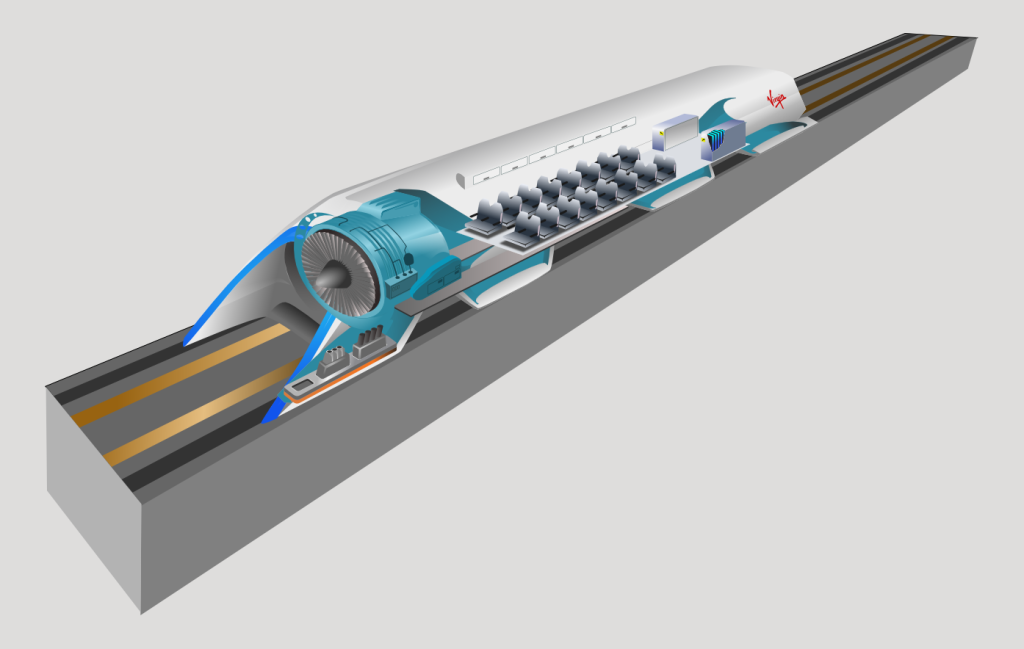
Concept art of Hyperloop inner workings (Wiki Image).
Sure, here are some more possible top inventions for automobiles between 2050 and 2250:
- Hyperloop: Hyperloop is a new mode of transportation that can travel up to 760 miles per hour. It uses a low-pressure tube and pods that levitate above the track using magnetic propulsion. Hyperloop is still in the early stages of development, but it has the potential to revolutionize transportation.
- Nuclear-powered cars: Nuclear-powered cars could use nuclear fusion or fission to generate electricity, providing a clean and long-lasting power source. This would eliminate the need for gasoline or other fossil fuels and reduce greenhouse gas emissions.
- Holographic cars: Holographic cars could use advanced projection technology to create a virtual image of a car around the driver. This would allow drivers to see their surroundings 360 degrees and avoid accidents.
- Telepathic cars: Telepathic cars could use brain-computer interfaces to read the driver’s thoughts and control the car accordingly. This would make driving more intuitive and safer, as drivers would not need to take their hands off the wheel or eyes off the road.
- Self-replicating cars: Self-replicating cars could use advanced nanotechnology to create copies of themselves. This would make it possible to produce cars much more cheaply and efficiently, and it would also make it possible to replace damaged or outdated cars quickly and easily.
- Time-traveling cars: Time-traveling cars could use theoretical physics to travel back in time. This would allow people to revisit past events or even change the course of history.
- Immortal cars: Immortal cars could use advanced nanotechnology to repair themselves and prevent damage. This would make cars last indefinitely, reducing the need to manufacture new cars and the environmental impact of car production.
- Cars that can communicate with other cars: Cars that can communicate with other cars could use sensors and wireless technology to share information about traffic conditions, road hazards, and other relevant information. This would help to prevent accidents and improve traffic flow.
- Cars that can drive themselves to the mechanic: Cars that can drive themselves to the mechanic could use sensors and GPS technology to identify when they need maintenance and then drive themselves to the nearest mechanic. This would save time and hassle for car owners.
- Cars that can clean themselves: They could use robotic arms and sensors to wash and wax themselves. This would save car owners time and effort and help keep their cars looking their best.
- Flying cars: Flying cars have been a staple of science fiction for decades but are now becoming a reality. Several companies are developing flying cars that could be used for personal transportation, commuting, and even emergency services.
These are just a few possible top automobile inventions between 2050 and 2250. As technology advances, we expect to see even more innovative and transformative developments in the automotive industry.
It will be fascinating to see what the future holds for automobiles. In the next few decades, we may see flying, time-traveling, or immortal cars!
AI Batteries Invention 2050-2250
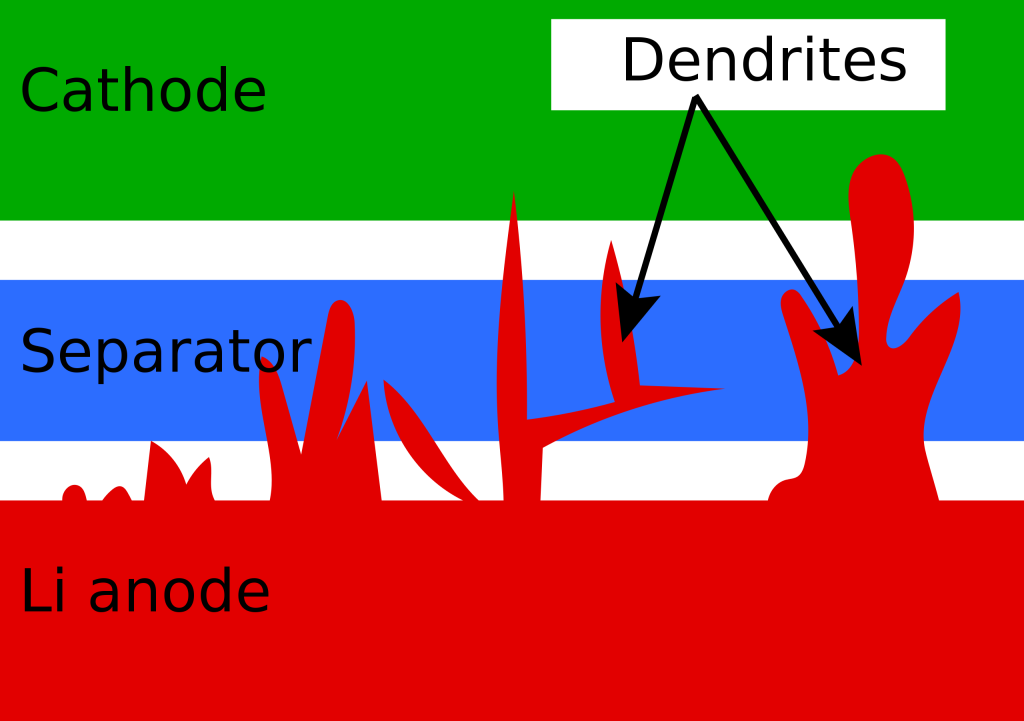
Lithium metal dendrite from the anode pierces through the separator and grows towards the cathode (Wiki Image).
Batteries are one of the most important inventions in history. They have revolutionized the way we live, work, and play. We would not have portable devices like smartphones, laptops, and tablets without batteries. We would also not have electric cars, which are becoming increasingly popular.
But batteries are not perfect. They are heavy, bulky, and can sometimes leak or explode. They also have a limited lifespan. These limitations are what researchers are working to overcome. They are developing new battery technologies that are lighter, more powerful, and longer-lasting.
One promising battery technology is solid-state batteries. These batteries use a solid electrolyte instead of a liquid one. This makes them more stable and less likely to leak. Solid-state batteries can also be charged and discharged more quickly than traditional batteries.
Another promising battery technology is lithium-sulfur batteries. These batteries use lithium and sulfur as electrodes. This combination allows for a higher energy density than traditional lithium-ion batteries. Lithium-sulfur batteries are also lighter and less expensive to manufacture.
Researchers are also developing batteries that can store renewable energy from solar and wind power sources. This would allow us to store energy when it is abundant and use it when needed.
Developing new battery technologies is among the most important challenges facing scientists and engineers today. These technologies can potentially revolutionize our world, making it more sustainable, efficient, and connected.
Here are some examples of how new battery technologies could benefit society:
- Electric cars: New battery technologies could make electric cars more affordable and practical. This could reduce our reliance on fossil fuels and improve air quality.
- Portable devices: New battery technologies could make portable devices smaller, lighter, and more powerful. This could lead to new applications for these devices, such as augmented and virtual reality.
- Medical devices: New battery technologies could make medical devices smaller, lighter, and more portable. This could improve the lives of patients who rely on these devices.
- Grid storage: New battery technologies could store renewable energy from solar and wind power sources. This could make our electricity grid more reliable and efficient.
The development of new battery technologies is a complex and expensive undertaking. However, the potential benefits are so great that it is worth the investment. We expect new battery technologies to change the world with continued research and development.
AI Big Bang Invention 2050-2250
The Big Bang is not an invention. It is the prevailing cosmological model for the universe. It offers a comprehensive explanation for a broad range of observed phenomena, including the abundance of light elements, the cosmic microwave background (CMB) radiation, and large-scale structure. The Big Bang theory is supported by a wide range of evidence, and it is the most widely accepted model for the origin and evolution of the universe.
Here are some of the top potential scientific breakthroughs that we can expect to see in cosmology between 2050 and 2250:
-
A theory of quantum gravity: Quantum gravity is a theory that would unify the theory of general relativity with quantum mechanics. A theory of quantum gravity would help us to understand the behavior of gravity at very small scales, such as the Planck scale.
-
The detection of dark matter and dark energy: Dark matter and dark energy are two of the biggest mysteries in cosmology. Dark matter is thought to make up about 85% of the matter in the universe, but we do not know what it is made of. Dark energy is thought to be responsible for the accelerated expansion of the universe, but we do not know what it is.
-
The discovery of new particles and forces: The Standard Model of particle physics is a theory that describes the fundamental particles and forces of nature. However, the Standard Model does not explain all of the observed phenomena in the universe. New particles and forces could help us to explain these phenomena.
-
The origin of the universe: The Big Bang theory is the most widely accepted model for the origin of the universe. However, there are still many unanswered questions about the Big Bang, such as what caused it and what happened in the first moments of the universe.
-
The existence of other universes: Our universe may not be the only one. There could be other universes with different laws of physics.
These are just a few of the many potential scientific breakthroughs that we can expect to see in cosmology between 2050 and 2250. Cosmology is a rapidly evolving field, and new discoveries are being made all the time. I am excited to see what the future holds for cosmology.
Overall, cosmology has the potential to make the world a better place in many ways by 2050 and 2250. Cosmology could help us to understand the origin and evolution of the universe, which could help us to understand our place in the cosmos. Cosmology could also help us to develop new technologies, such as quantum computers and new forms of energy.
However, it is important to use cosmology responsibly and to mitigate any potential risks. For example, if we discover that there are other universes with different laws of physics, we need to be careful not to interfere with them.
I am excited to see how cosmology technology develops in the coming decades. Cosmology has the potential to make the world a better place for everyone.
Here are some specific examples of how new cosmological discoveries could be used:
- A theory of quantum gravity could help us to develop new technologies, such as warp drives and time machines.
- The detection of dark matter and dark energy could help us to understand the origin and evolution of the universe.
- The discovery of new particles and forces could help us to develop new technologies, such as new forms of energy.
- A better understanding of the origin of the universe could help us to appreciate our place in the cosmos.
- The discovery of other universes could lead to new theories about the nature of reality.
I believe that these breakthroughs have the potential to revolutionize our understanding of the universe. By making new discoveries in cosmology, we can expand our knowledge of the cosmos and our place in it.
AI Biotechnology Invention 2050-2250
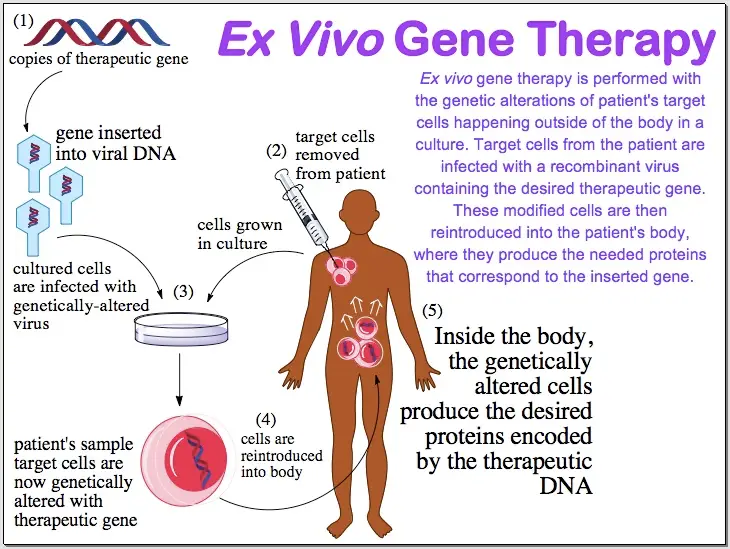
(Wiki Image).
Biotechnology is a broad field that encompasses various technologies and techniques used to manipulate living organisms or their components to produce new products or processes. It has revolutionized various industries, including healthcare, agriculture, and manufacturing, and its impact is expected to grow even further in the coming decades.
Here are some potential breakthrough inventions in biotechnology between 2050 and 2250:
- Gene therapy: Gene therapy is a promising approach to treating genetic disorders by correcting faulty genes. Significant advancements in gene editing techniques, such as CRISPR-Cas9, could lead to more effective and safe gene therapies for many diseases, including cystic fibrosis, sickle cell anemia, and hemophilia.
- Regenerative medicine: Regenerative medicine aims to repair or replace damaged tissues and organs. Advancements in stem cell research and tissue engineering could enable heart tissue regeneration, spinal cord injuries, and even entire organs, potentially curing degenerative diseases and extending human lifespans.
- Personalized medicine: Personalized medicine is a healthcare approach that tailors treatments and medications to an individual’s genetic makeup and health profile. By analyzing genetic data and other biomarkers, doctors could develop more effective personalized treatment plans with fewer side effects.
- Novel drug discovery: Biotechnology is increasingly important in drug discovery. AI-powered algorithms and high-throughput screening techniques could accelerate the discovery of new drugs with enhanced efficacy and reduced side effects.
- Biofuels and sustainable agriculture: Biotechnology could lead to the development of new biofuels produced from renewable resources, such as algae or plant biomass. This could help reduce our reliance on fossil fuels and mitigate climate change.
- Environmental remediation: Biotechnology could be used to develop microorganisms or enzymes that can degrade pollutants and clean up contaminated sites. This could help restore ecosystems and protect the environment.
- Biomanufacturing: Biotechnology is increasingly used in manufacturing processes to produce various products, such as pharmaceuticals, enzymes, and bioplastics. Advancements in fermentation technology and synthetic biology could lead to more efficient and sustainable biomanufacturing processes.
- Human augmentation: Biotechnology could enhance human capabilities by repairing or replacing damaged tissues and organs or introducing new functionalities. While ethical considerations surround human augmentation, it can improve health and performance.
These are just a few examples of how biotechnology could transform various aspects of our lives in the coming decades. As our understanding of biology and genetics continues to grow, we can expect even more groundbreaking inventions in biotechnology with the potential to revolutionize healthcare, agriculture, manufacturing, and environmental protection.
AI Black Hole Invention 2050-2250

An artist’s conception of a supermassive black hole surrounded by an accretion disk and emitting a relativistic jet (Wiki Image).
Black holes are one of the universe’s most mysterious and fascinating objects. They are regions of spacetime where gravity is so strong that nothing, not even light, can escape. Black holes are thought to be formed when massive stars collapse at the end of their lives.
In the next 50 to 250 years, we can expect significant advances in understanding black holes. This will be partly due to the development of new technologies, such as more powerful telescopes and gravitational wave detectors.
One of the most promising research areas in black hole physics is the study of black hole mergers. Black hole mergers are considered one of the universe’s most powerful and energetic events. They can produce gravitational waves that gravitational wave detectors can detect.
Another promising area of research is the study of black hole jets. Black hole jets are powerful streams of matter ejected from black holes. Black hole jets, thought to play a role in forming stars and galaxies, can be seen in many galaxies.
In addition to advances in our understanding of black holes, we can also expect to see new technologies that are inspired by black holes. For example, black holes could be used to develop new types of telescopes and gravitational wave detectors. Black holes could also be used to develop new energy sources and propulsion systems.
Here are some specific examples of how advances in black hole research could be used in the future:
- New telescopes: Black hole mergers could be used to calibrate new telescopes. This would allow us to create more accurate maps of the universe and to study distant objects in more detail.
- New gravitational wave detectors: Black hole mergers could be used to develop new gravitational wave detectors. This would allow us to study black holes and other cosmic objects more deeply.
- New energy sources: Black holes could be used to develop new energy sources. For example, the energy released from black hole mergers could be used to power starships or space colonies.
- New propulsion systems: Black holes could be used to develop new propulsion systems. For example, black hole jets could propel starships at speeds close to the speed of light.
Overall, the future of black hole research is very bright. Advances in black hole research have the potential to revolutionize our understanding of the universe and lead to the development of new technologies that could benefit humanity in many ways.
It is important to note that black holes are still very mysterious objects, and there is much that we do not know about them. However, the rapid progress made in black hole research is very promising. In the next 50 to 250 years, we can expect to learn much more about black holes and their role in the universe.
AI Brain-computer Interfaces Invention 2050-2250
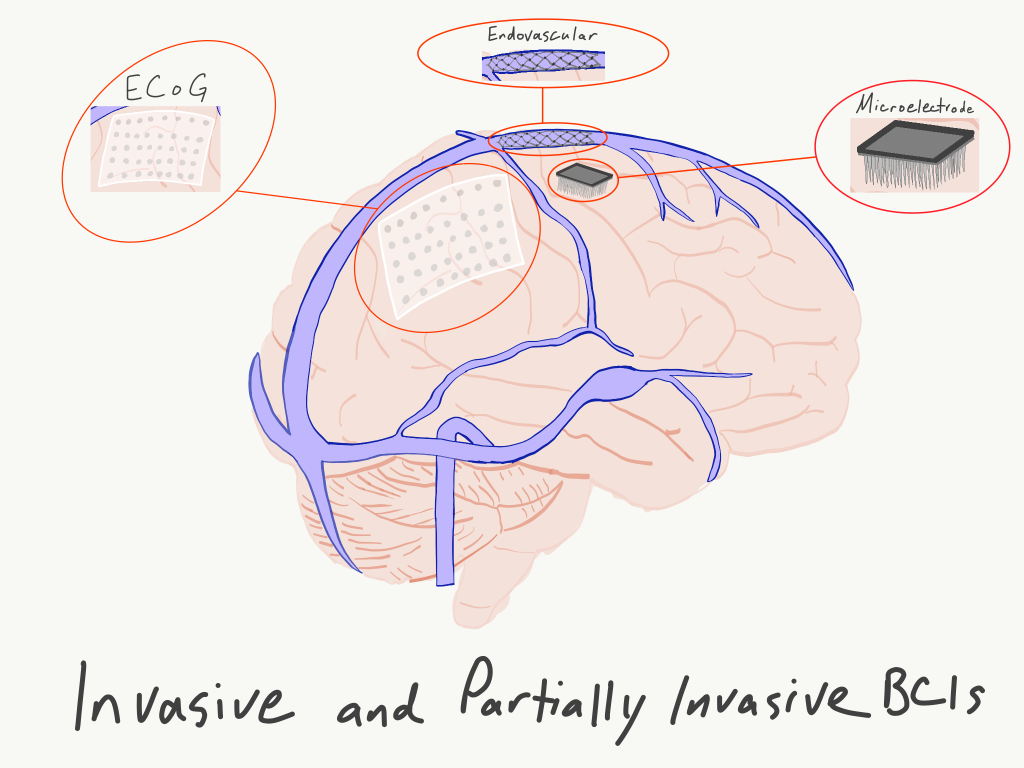
Illustration of invasive and partially invasive BCIs: electrocorticography (ECoG), endovascular, and intracortical microelectrode (Wiki Image).
Brain-computer interfaces (BCIs) allow us to communicate directly with our computers and other devices using our minds. They have the potential to revolutionize many aspects of our lives, from how we interact with our devices to how we treat diseases.
BCIs record the brain’s electrical activity and translate it into signals that a computer can interpret. This can be done in many ways, but the most common approach is to use electrodes implanted on the brain’s surface or inserted into the skull.
BCIs have several potential applications. They can control computers and other devices, such as prosthetic limbs and wheelchairs. They can also be used to communicate with people who cannot speak, such as those with paralysis or locked-in syndrome.
In addition, BCIs have the potential to be used to treat a variety of neurological disorders, such as Parkinson’s disease, epilepsy, and stroke. BCIs could also be used to improve cognitive function and memory.
BCI technology is still in its early stages of development, but it has the potential to have a major impact on the world in the coming decades.
Here are some potential benefits of BCIs:
- Improved communication: BCIs allow people who cannot speak to communicate with others. This could improve the quality of life for people with paralysis, locked-in syndrome, and other communication disorders.
- Enhanced control of devices: BCIs could allow people to control devices such as computers and prosthetic limbs with their minds. This could give people with disabilities more independence and improve their ability to interact with the world around them.
- New treatments for neurological disorders: BCIs could be used to develop new treatments for a variety of neurological disorders, such as Parkinson’s disease, epilepsy, and stroke. BCIs could also be used to improve cognitive function and memory.
- New forms of entertainment and education: BCIs could be used to develop new forms. For example, BCIs could be used to create virtual reality experiences that are more immersive and realistic than current technologies.
Some challenges need to be overcome before BCIs can be fully commercialized:
- Safety: BCIs need to be safe and reliable before they can be implanted in humans. There is a risk of infection and other complications with any surgery, and BCIs are no exception.
- Cost: BCIs are currently very expensive. The cost of BCIs must come down before they can be widely adopted.
- Ease of use: BCIs must be easy to use and calibrate. This is a challenge because the brain is a complex organ, and its signals can vary from person to person.
- Social acceptance: BCIs are a new technology, and there may be some social resistance to their adoption. For example, some people may be concerned about the potential for BCIs to be used to control people’s minds.
Despite these challenges, the potential benefits of BCIs are vast. BCIs have the potential to revolutionize many aspects of our lives, from the way we interact with our devices to the way we treat diseases.
AI Camera Invention 2050-2250

Computational photography provides many new capabilities. This example combines HDR (High Dynamic Range) imaging with panoramics (image-stitching) by optimally combining information from multiple differently exposed pictures of overlapping subject matter (Wiki Image).
Cameras are among the most ubiquitous and popular inventions ever. They have revolutionized how we capture and share memories and have played a major role in many fields, including journalism, science, and art. In the next 50 to 250 years, we can expect to see even more dramatic advances in camera technology.
One of the most promising research areas in camera technology is the development of new image sensors. Image sensors are the devices that capture light and convert it into digital images. New image sensors with higher resolutions, greater dynamic range, and improved low-light performance could revolutionize how we take pictures and videos.
Another promising area of research is the development of new camera lenses. Camera lenses are responsible for focusing and gathering light, and they have a major impact on the quality of images. New camera lenses with improved optical performance and smaller form factors could enable the development of new types of cameras, such as smaller and more lightweight smartphones and drones.
In addition to advances in image sensors and lenses, we can also expect to see advances in other areas of camera technology, such as:
- Computational photography: Computational photography is a field that combines computer science and photography to develop new ways to capture and process images. Advances in computational photography could lead to the development of cameras that can automatically correct image defects, remove unwanted objects from images, and even create 3D images from 2D images.
- Artificial intelligence (AI): AI is already being used in some cameras to improve features such as autofocus and image recognition. In the future, AI could be used to develop cameras that can automatically take the perfect picture or video, even in challenging conditions.
- Miniaturization: Cameras are becoming increasingly smaller and lighter, which is expected to continue. This could enable the development of new types of cameras, such as wearable cameras and cameras that can be embedded in objects.
These advances in camera technology will have a major impact on the way we live and work in the future. Cameras will become even more ubiquitous and be used in various applications.
Here are some examples of how technological advances could be used in the future:
- Medical imaging: New camera technologies could be used to develop more advanced medical imaging devices, such as MRI and CT scanners. This could lead to earlier and more accurate diagnoses of diseases.
- Security and surveillance: New camera technologies could be used to develop more sophisticated security and surveillance systems. This could help to prevent crime and improve public safety.
- Augmented reality (AR) and virtual reality (VR): New camera technologies could be used to develop more immersive AR and VR experiences. This could have applications in gaming, education, and entertainment.
- Self-driving cars: New camera technologies could be used to develop self-driving cars that can see and navigate the world around them more accurately. This could make self-driving cars safer and more reliable.
Overall, the future of camera technology is very bright. Advances in camera technology have the potential to improve many industries and make our lives better in many ways.
AI Chemistry Invention 2050-2250
Chemistry is a dynamic field that is constantly evolving. As technology advances, we can expect to see even more innovative and transformative developments in chemistry between 2050 and 2250. Here are some potential top inventions in chemistry that we can expect to see:
-
New materials with unique properties: Chemists are developing new materials with unique properties, such as super strength, self-healing capabilities, and the ability to conduct electricity or light. These new materials could have a wide range of applications, from construction to medicine to electronics.
-
New methods for synthesizing complex molecules: Chemists are developing new methods for synthesizing complex molecules, such as pharmaceuticals and new materials. These new methods could make it possible to create new drugs and materials more quickly and efficiently.
-
New methods for storing and converting energy: Chemists are developing new methods for storing and converting energy. These new methods could help us to develop more sustainable and efficient energy sources.
-
New methods for cleaning up pollution: Chemists are developing new methods for cleaning up pollution. These new methods could help us to protect the environment and improve public health.
-
New methods for personalizing medicine: Chemists are developing new methods for personalizing medicine. These new methods could help us to develop more effective treatments for diseases.
These are just a few potential top inventions in chemistry that we can expect to see in the coming decades. Chemistry has the potential to revolutionize many aspects of our lives, from the way we build things to the way we treat diseases. I am excited to see how chemistry technology develops in the coming decades. Chemistry has the potential to make the world a better place for everyone.
Here are some specific examples of how new chemical discoveries could be used:
- New materials with unique properties could be used to build stronger and more durable structures.
- New methods for synthesizing complex molecules could be used to create new drugs and materials more quickly and efficiently.
- New methods for storing and converting energy could help us to develop more sustainable and efficient energy sources.
- New methods for cleaning up pollution could help us to protect the environment and improve public health.
- New methods for personalizing medicine could help us to develop more effective treatments for diseases.
I believe that these breakthroughs have the potential to revolutionize many aspects of our lives. By making new discoveries in chemistry, we can improve our quality of life, protect the environment, and even extend our lifespans.
AI Computers Invention 2050-2250

IBM Q System One, a quantum computer with 20 superconducting qubits (Wiki Image).
Computers are one of the most important inventions in human history. They have revolutionized many industries and become essential to our daily lives. In the next 50 to 250 years, we expect to see even more dramatic advances in computer technology.
One of the most promising research areas in computer technology is the development of new quantum computers. Quantum computers are based on the principles of quantum mechanics, which allow them to perform calculations that are impossible for traditional computers. Quantum computers can potentially revolutionize many fields, including medicine, materials science, and artificial intelligence.
Another promising area of research is the development of new neuromorphic computers. Neuromorphic computers are inspired by the human brain and are designed to be more efficient at processing large amounts of data. Neuromorphic computers could be used to develop new applications in artificial intelligence, machine learning, and data mining.
In addition to advances in quantum computing and neuromorphic computing, we can also expect to see advances in other areas of computer technology, such as:
- Artificial intelligence: Artificial intelligence is the field of computer science that deals with creating intelligent agents, which are systems that can reason, learn, and act autonomously. Artificial intelligence is already used in various applications, such as self-driving cars, virtual assistants, and medical diagnosis. Artificial intelligence is expected to become even more sophisticated and be used in various applications.
- Machine learning: Machine learning is a subset of artificial intelligence that develops algorithms that can learn from data without being explicitly programmed. Machine learning is already being used in various applications, such as fraud detection, product recommendation, and image recognition. Machine learning is expected to become even more powerful and be used in various applications.
- Data mining: Data mining is extracting knowledge from large amounts of data. Data mining is already used in various applications, such as market research, customer segmentation, and risk assessment. Data mining is expected to become even more sophisticated and be used in various applications.
These advances in computer technology will have a major impact on the way we live and work in the future. Computers will become even more ubiquitous and be used in various applications.
Here are some specific examples of how advances in computer technology could be used in the future:
- Quantum computers for drug discovery: Quantum computers could accelerate the drug discovery process by simulating the behavior of molecules. This could lead to the development new drugs that are more effective and have fewer side effects.
- Neuromorphic computers for image recognition: Neuromorphic computers could be used to develop new image recognition systems that are more accurate and efficient than current systems. This could be used to improve the performance of self-driving cars, security systems, and other applications that rely on image recognition.
- Artificial intelligence for personalized medicine: Artificial intelligence could be used to develop personalized medicine treatments tailored to the individual patient’s genetic makeup and medical history. This could lead to more effective treatments and better outcomes for patients.
- Machine learning for fraud detection: Machine learning could be used to develop new fraud detection systems that more effectively identify and prevent fraudulent transactions. This could help to protect businesses and consumers from financial losses.
- Data mining for market research: Data mining could extract valuable insights from market data. Businesses could use this to improve their marketing strategies and develop new products and services that meet the needs of their customers.
Overall, the future of computer technology is very bright. Advances in computer technology have the potential to improve many industries and to make our lives better in many ways.
AI DNA Invention 2050-2250
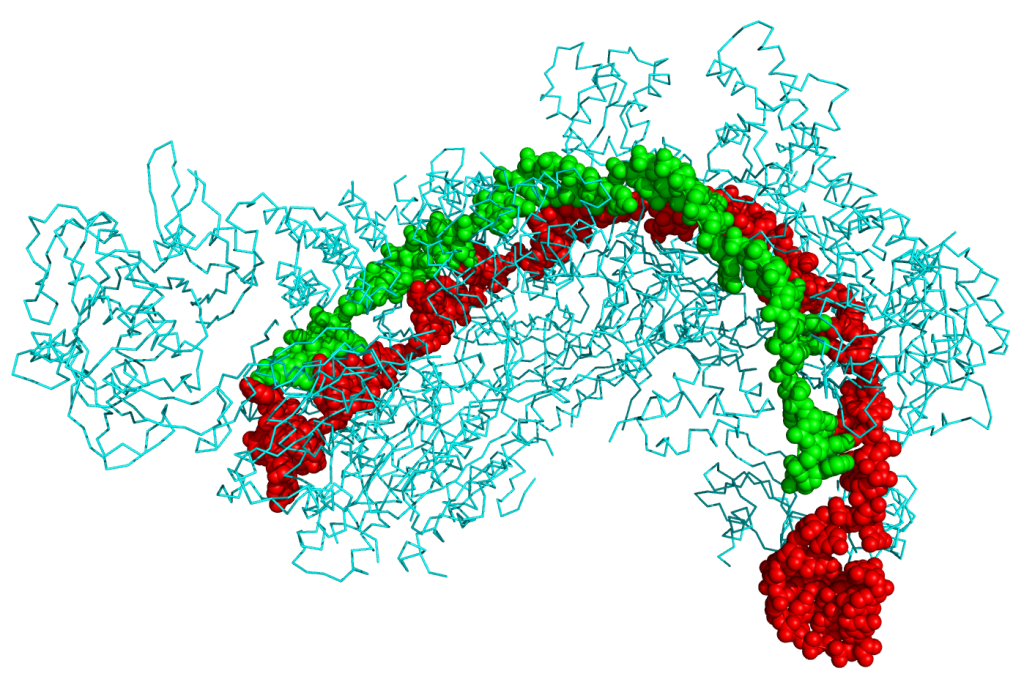
CRISPR Cascade protein (cyan) bound to CRISPR RNA (green) and phage DNA (red) (Wiki Image).
DNA is the genetic material found in all living organisms. It contains the instructions for building and maintaining life. DNA is a powerful tool that can be used to improve human health, agriculture, and other fields.
In the next 50 to 250 years, we expect to see even more dramatic advances in DNA technology. These advances will allow us to better understand and manipulate DNA, which could lead to a wide range of new applications.
One of the most promising research areas in DNA technology is the development of gene editing tools such as CRISPR-Cas9. CRISPR-Cas9 is a powerful tool that can be used to make precise edits to an organism’s genome. This could be used to correct genetic mutations that cause diseases, to introduce new genes into an organism, or to remove unwanted genes.
Another promising area of research is the development of synthetic biology. Synthetic biology is the design and construction of new biological systems. This could create new organisms that can perform specific tasks, such as producing biofuels or cleaning up pollution.
In addition, advances in DNA sequencing and analysis will allow us to better understand the human genome and the genomes of other organisms. This could lead to new insights into the causes of diseases, the development of new drugs and treatments, and the creation of new crops and livestock.
Here are some specific examples of how advances in DNA technology could be used in the future:
- Gene editing to cure diseases: Gene editing could correct genetic mutations that cause cancer, cystic fibrosis, and sickle cell anemia.
- Gene editing to improve crops: Gene editing could be used to create crops that are more resistant to pests and diseases, more nutritious, and more tolerant of drought and other environmental stresses.
- Gene editing to improve livestock: Gene editing could create more productivity, disease resistance, and efficiency in converting feed into meat or milk.
- Synthetic biology to produce biofuels: Synthetic biology could create new organisms that can produce biofuels from renewable resources such as sunlight and algae.
- Synthetic biology to clean up pollution: Synthetic biology could create new organisms to clean up pollution from soil, water, and air.
Overall, the future of DNA technology is very bright. DNA technology advances can improve human health, agriculture, and many other fields.
AI Drone Invention 2050-2250
Here are some potential top inventions in drones between 2050 and 2250:
-
Self-driving drones: Self-driving drones would be able to navigate and operate without human intervention. This would make them more versatile and safer to use. Self-driving drones could be used for a variety of applications, such as delivery, surveillance, and personal transportation.
-
Swarm drones: Swarm drones are groups of drones that work together to achieve a common goal. Swarm drones could be used for a variety of applications, such as search and rescue, disaster relief, and military operations.
-
Delivery drones: Delivery drones are already being used to deliver packages in some parts of the world. In the future, delivery drones could be used to deliver a wider variety of goods, including food, medicine, and even people.
-
Surveillance drones: Surveillance drones are already being used by the military and law enforcement. In the future, surveillance drones could be used for a wider variety of purposes, such as monitoring traffic, tracking criminals, and inspecting infrastructure.
-
Personal transportation drones: Personal transportation drones are hypothetical drones that could be used to transport people. Personal transportation drones could revolutionize transportation by making it faster, cheaper, and more convenient.
These are just a few potential top inventions in drones between 2050 and 2250. As technology continues to advance, we can expect to see even more innovative and transformative developments in this field.
Drones have the potential to revolutionize many aspects of our lives. They could make transportation faster, safer, and more convenient. They could help us to monitor our environment and respond to disasters more effectively. They could even make it possible for us to live and work in places that are currently inaccessible.
I am excited to see how drone technology develops in the coming decades. Drones have the potential to make the world a better place for everyone.
Here are some specific examples of how new drone inventions could be used:
- Self-driving drones could be used to deliver packages to people’s homes without the need for a human driver.
- Swarm drones could be used to search for survivors in a disaster zone or to inspect the damage to infrastructure after a natural disaster.
- Delivery drones could be used to deliver food and medicine to people in remote areas.
- Surveillance drones could be used to monitor traffic and identify potential threats to public safety.
- Personal transportation drones could be used to commute to work or to visit friends and family.
I believe that these breakthroughs have the potential to change the world in many ways. By developing new drone technology, we can improve our quality of life, make our transportation system more efficient, and protect our environment.
AI Extra-terrestrial Invention 2050-2250
The search for extraterrestrial life (ET) is a broad field of inquiry that encompasses many different scientific disciplines, including astronomy, astrobiology, biology, chemistry, and physics. The ultimate goal of this search is to find and study life beyond Earth, whether it be simple microorganisms or complex, intelligent beings.
There are many different reasons to believe that ET may exist. The universe is vast and contains billions of galaxies, each with billions of stars. Many of these stars are likely to have planets that could support life. In addition, we have recently discovered a large number of exoplanets, or planets, that orbit stars other than our own Sun. Some of these exoplanets are Earth-sized and located in the habitable zones of their stars, which means that they could potentially support liquid water on their surfaces.
Despite the many reasons to believe that ET may exist, we have yet to find any definitive evidence of life beyond Earth. This is likely due to the vast distances between stars and the challenges of detecting life on other planets. However, we are constantly improving our technology and understanding of the universe and becoming increasingly confident that we will eventually find ET.
The discovery of ET would be a momentous event that would profoundly impact our understanding of the universe and our place in it. It would also have a significant impact on our culture, our economy, and our future.
Here are some of the potential consequences of discovering ET:
- A new understanding of the universe: The discovery of ET would show that we are not alone in the universe and that life can exist in other places. This would profoundly impact our understanding of the cosmos and our place in it.
- A new perspective on our own planet: The discovery of ET would give us a new perspective on our planet and species. We would realize that we are just one small part of a vast and diverse universe.
- New opportunities for scientific discovery: The discovery of ET would open up new avenues for scientific research. We could study the biology, chemistry, and physics of ET and learn more about the origins of life and the potential for life on other planets.
- New challenges and opportunities for humanity: The discovery of ET would also present new challenges and opportunities for humanity. We would need to decide how to interact with ET and how to deal with the potential ethical and social implications of our discovery.
The discovery of ET would be a transformative event that would change our understanding of the universe and our place in it. It would also have a profound impact on our culture, our economy, and our future.
AI Film Invention 2050-2250
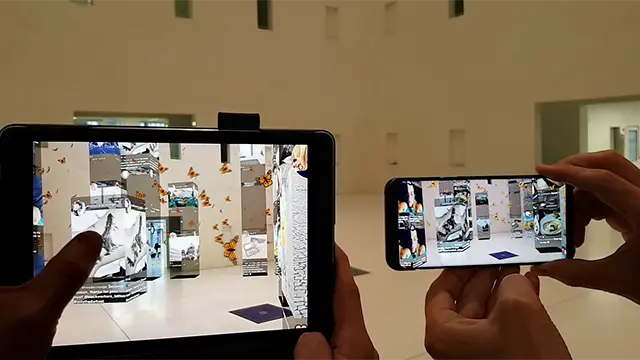
10.000 Moving Cities, Marc Lee, Augmented Reality Multiplayer Game, Art Installation (Wiki Image).
Film is a medium for storytelling and entertainment that has been around for over a century. It has evolved dramatically, from silent films to black-and-white films to color and digital films. In the next 50 to 250 years, we expect to see even more dramatic advances in film technology.
One of the most promising research areas in film technology is the development of new display technologies. New display technologies with higher resolutions, wider color gamuts, and higher refresh rates could revolutionize how we watch movies. For example, new display technologies could enable the development of holographic films and films that can be viewed 360 degrees.
Another promising area of research is the development of new film production technologies. New film production technologies, such as virtual and augmented reality, could make creating high-quality films easier and more affordable. For example, virtual production could allow filmmakers to shoot scenes in virtual environments, while augmented reality could overlay computer-generated images onto real-world scenes.
In addition to advances in display and production technologies, we can also expect to see advances in other areas of film technology, such as:
- Storytelling: Filmmakers constantly experiment with new ways to tell stories through film. We can expect to see even more innovative and immersive storytelling techniques. For example, filmmakers could use artificial intelligence to generate personalized stories for viewers or create interactive films that allow viewers to make choices that affect the story’s outcome.
- Distribution: How we distribute and consume films is also changing rapidly. In the future, we expect to see more films being released directly to streaming services and more people watching films on mobile devices. This could lead to new opportunities for filmmakers to reach their audiences.
These advances in film technology will have a major impact on the way we watch and experience films in the future. Films are likely to become even more immersive and engaging, and they will be accessible to people worldwide.
Here are some specific examples of how advances in film technology could be used in the future:
- Holographic films: Holographic films could create the illusion that the characters and objects in the film are real. This would make films more immersive and engaging for viewers.
- 360-degree films: 360-degree films allow viewers to watch films from any angle. This would give viewers more control over their viewing experience and allow them to explore the world of the film in more detail.
- Virtual production: Virtual production could allow filmmakers to shoot scenes in virtual environments. This would reduce the need for physical sets and locations and give filmmakers more creative freedom.
- Augmented reality: Augmented reality could overlay computer-generated images onto real-world scenes. This could be used to create more realistic and immersive films.
- Personalized storytelling: Artificial intelligence could be used to generate personalized stories for viewers. This would allow viewers to watch films that are tailored to their interests.
- Interactive films: Interactive films allow viewers to make choices that affect the story’s outcome. This would make films more engaging and interactive for viewers.
- Direct-to-streaming releases: More films could be released directly to streaming services. This would give viewers more flexibility in how and when they watch films.
- Mobile viewing: More people can watch films on mobile devices. This would make films more accessible to people all over the world.
Overall, the future of film technology is very bright. Advances in film technology can potentially revolutionize how we watch and experience films.
AI Food Invention 2050-2250
As the world’s population continues to grow and climate change threatens food production, scientists and entrepreneurs are developing new and innovative ways to produce and consume food in the future. Here are some of the most exciting food-related inventions that are likely to emerge between 2050 and 2250:
-
- Vertical farms: Vertical farms are indoor farms that use hydroponics or aeroponics to grow crops without soil. Vertical farms can be stacked on top of each other, allowing farmers to produce more food in less space. Vertical farms can be located in urban areas, which can help to reduce the need for transportation and make fresh produce more accessible to consumers.
-
- Lab-grown meat: Lab-grown meat or plant-based meat is produced using cell culture technology rather than by raising and slaughtering animals. Lab-grown meat could help to reduce the environmental impact of meat production, which is a major contributor to climate change. It could also improve food safety and help address concerns about animal welfare.
-
- Genetically modified (GM) foods: GM foods are foods that have been genetically altered to improve their nutritional content, taste, or resistance to pests and diseases. GM foods have the potential to help to address food security, nutrition, and sustainability challenges. However, there are also concerns about the potential risks of GM foods, such as the potential for unintended effects on human health and the environment.
-
- Personalized nutrition: Personalized nutrition is the use of genetic and other personal data to create customized diets and food recommendations. Personalized nutrition could help people to optimize their health by providing them with the right nutrients for their individual needs.
-
- 3D-printed food: 3D-printed food is food that is created by depositing layers of material, such as edible pastes or gels. 3D-printed food could be used to create customized dishes with complex shapes and flavors. It could also help to reduce food waste by allowing chefs to create precise portions.
These are just a few of the exciting food-related inventions that are likely to emerge in the future. These inventions have the potential to revolutionize the way we produce and consume food, which could help address the challenges of food security, nutrition, and sustainability. It is important to note that these inventions are still in development, and there are some potential challenges that need to be addressed before they can be widely adopted. For example, vertical farms can be expensive to build and operate, lab-grown meat is still in its early stages of development and may be too expensive for consumers, GM foods may raise concerns about safety and ethics, personalized nutrition may be difficult and expensive to provide, and 3D-printed food may not be as appealing to consumers as traditional food. However, these challenges are being addressed, and we can expect to see significant progress in these areas in the years to come. I am excited to see how these new food inventions develop in the coming decades. These inventions have the potential to make the world a more sustainable and equitable place for everyone. I hope that these new food inventions can help us to address the challenges of food security, nutrition, and sustainability. If you have any other questions or requests, let me know.
AI Fusion Invention 2050-2250
Fusion, laser fusion, and ITER Max are all potential game-changers in the world of energy. They have the potential to revolutionize the way we generate electricity and power our world. Here’s a quick overview of each:
-
- Fusion: Nuclear fusion is the process of combining two or more atomic nuclei to form a heavier nucleus, releasing a large amount of energy in the process. It is the same process that powers the sun and other stars. Fusion energy is a clean, safe, and abundant source of energy, and it has the potential to meet our energy needs for centuries to come.
-
- Laser fusion: Laser fusion is a type of fusion that uses lasers to heat and compress fuel pellets to the point where fusion occurs. Laser fusion is still in the early stages of development, but it has the potential to be a more efficient and economical way to generate fusion energy than traditional methods.
-
- ITER Max: ITER Max is an international project to build the world’s largest and most powerful tokamak, a type of device that uses a magnetic field to confine a plasma of hot ionized gas. ITER Max is expected to begin operating in the 2030s, and it is hoped that it will demonstrate the feasibility of fusion energy on a commercial scale.
These are just a few of the many potential benefits of fusion, laser fusion, and ITER Max. These technologies have the potential to reduce our reliance on fossil fuels, combat climate change, and provide a clean, safe, and abundant source of energy for the future.
I am excited to see how these technologies develop in the coming years. They have the potential to make a real difference in our world. If you have any other questions or requests, let me know.
AI Garbage Invention 2050-2250
As the world’s population continues to grow, the problem of waste disposal is becoming increasingly pressing. Scientists and engineers are working on new and innovative ways to reduce waste, reuse materials, and convert waste into energy. Here are some of the top inventions in waste management that we can expect to see in the future:
-
Advanced recycling: New technologies are being developed that can make recycling more efficient and cost-effective. This includes new methods for sorting and separating different types of materials, as well as new ways to break down materials that were previously considered unrecyclable.
-
Composting: Composting is the process of breaking down organic waste into nutrient-rich soil amendment. Composting can be done at home, in community gardens, or on a large scale by commercial composting facilities.
-
Anaerobic digestion: Anaerobic digestion is the process of breaking down organic waste in the absence of oxygen. This process produces biogas, which can be used to generate electricity or heat.
-
Waste-to-energy: Waste-to-energy incineration plants burn waste to generate electricity. Waste-to-energy plants can help to reduce the amount of waste that goes to landfills and can also generate a renewable source of energy.
-
Upcycling: Upcycling is the process of turning discarded materials into new products. Upcycling can be done by individuals, businesses, or communities.
These are just a few of the many innovative waste management solutions that are being developed. These solutions have the potential to reduce our reliance on landfills, conserve resources, and protect the environment.
In addition to the technologies mentioned above, there are a number of other trends that are shaping the future of waste management. These include:
- The circular economy: The circular economy is a model of production and consumption that aims to eliminate waste by designing products and systems that can be reused, recycled, or remanufactured.
- Zero-waste initiatives: Zero-waste initiatives aim to reduce waste to zero by implementing a combination of waste reduction, reuse, and recycling strategies.
- The use of technology: Technology is playing an increasingly important role in waste management. This includes the use of sensors to monitor waste streams, artificial intelligence to optimize waste collection routes, and blockchain technology to track the movement of materials.
- Public awareness: Public awareness of the environmental and social impacts of waste is increasing. This is leading to a growing demand for sustainable waste management solutions.
I am excited to see how waste management technologies and practices evolve in the coming years. I believe that these innovations have the potential to make a real difference in the world.
If you have any other questions, let me know.
AI Genetic Engineering Invention 2050-2250
Genetic engineering is a powerful tool that has the potential to revolutionize many aspects of our lives. Between 2050 and 2250, we can expect to see even more innovative and transformative developments in this field. Here are some of the top potential genetic engineering inventions that we can expect to see:
-
Gene editing: Gene editing is a technique that can be used to make precise changes to the DNA of an organism. Gene editing has the potential to cure genetic diseases, improve crops and livestock, and even create new species.
-
Gene therapy: Gene therapy is a technique that can be used to treat genetic diseases by introducing genes into the body to correct a genetic defect. Gene therapy has the potential to cure a wide range of diseases, including cystic fibrosis, sickle cell anemia, and hemophilia.
-
Personalized medicine: Personalized medicine is the use of genetic information to tailor medical treatments to the individual needs of each patient. Personalized medicine has the potential to improve the effectiveness of treatments and reduce side effects.
-
Xenotransplantation: Xenotransplantation is the transplantation of organs or tissues from one species to another. Xenotransplantation has the potential to address the shortage of organs available for transplantation.
-
Designer babies: Designer babies are babies that have been genetically engineered to have certain traits, such as intelligence, athletic ability, or a specific appearance. Designer babies raise a number of ethical concerns, but they are a possibility that we may need to consider in the future.
These are just a few of the many potential genetic engineering inventions that we can expect to see in the coming decades. Genetic engineering has the potential to revolutionize many aspects of our lives, from the way we treat diseases to the way we create new products. However, it is important to use genetic engineering responsibly and to mitigate any potential risks.
I am excited to see how genetic engineering technology develops in the coming decades. Genetic engineering has the potential to make the world a better place for everyone.
Here are some specific examples of how new genetic engineering inventions could be used:
- Gene editing could be used to cure genetic diseases such as cystic fibrosis, sickle cell anemia, and hemophilia.
- Gene therapy could be used to treat a wide range of diseases, including cancer, heart disease, and stroke.
- Personalized medicine could be used to tailor medical treatments to the individual needs of each patient, which could improve the effectiveness of treatments and reduce side effects.
- Xenotransplantation could be used to address the shortage of organs available for transplantation, which could save the lives of thousands of people each year.
I believe that these breakthroughs have the potential to revolutionize many aspects of our lives. By making new discoveries in genetic engineering, we can improve our health, extend our lifespans, and even create new species.
However, it is important to use genetic engineering responsibly and to mitigate any potential risks. For example, we need to be careful not to create new diseases or to harm the environment. We also need to make sure that genetic engineering is available to everyone, not just the wealthy.
I am optimistic that genetic engineering can be used to make the world a better place. However, we need to use this technology wisely and carefully.
If you have any other questions, let me know.
AI Grand Unified Theory Invention 2050-2250

Simulated Large Hadron Collider CMS particle detector data depicting a Higgs boson produced by colliding protons decaying into hadron jets and electrons (Wiki Images).
A Grand Unified Theory (GUT) is a hypothetical, all-encompassing, coherent theoretical framework of physics that fully explains and links together all known physical forces and laws.
A GUT has several important potential benefits, including:
- Explaining all four fundamental forces: A GUT would provide a single, unified explanation for all four fundamental forces of nature: gravity, electromagnetism, the strong force, and the weak force. This would be a major breakthrough in physics, as it would help us to better understand the forces that govern the universe.
- Unifying our current theories: A GUT would unify our physical theories, such as quantum mechanics and general relativity. These theories are currently separate and distinct, and some areas are incompatible. A GUT would provide a single, unified framework for understanding physics.
- Leading to new technological advances: A GUT could lead to new technological advances, such as new forms of energy and new materials. For example, a GUT could help us develop fusion reactors, providing a clean and abundant energy source. It could also help us develop stronger, lighter, and more durable materials than we have today.
Here are some specific examples of how a GUT could be used:
- To develop new methods of fusion power: Fusion power is a clean and abundant energy source, but it has been difficult to achieve and control. A GUT could help us to develop new fusion reactors that are more efficient and easier to operate.
- To develop new materials with extraordinary properties: A GUT could help us to develop new materials that are stronger, lighter, and more durable than anything we have today. These materials could be used in various applications, such as construction, transportation, and aerospace.
- To develop new ways to travel through space: A GUT could help us to develop new ways to travel through space, such as warp drives. This would allow us to travel to distant stars and planets faster than we can today.
- To better understand the early universe: The early universe was extremely hot and dense, and the four fundamental forces are thought to have been unified at that time. A GUT could help us to understand how the forces separated and how the universe evolved into its current state.
Overall, a GUT is a highly anticipated and sought-after theory in physics. It has the potential to revolutionize our understanding of the universe and lead to new technological advances that could improve our lives in many ways.
AI Heat Engine Invention 2050-2250
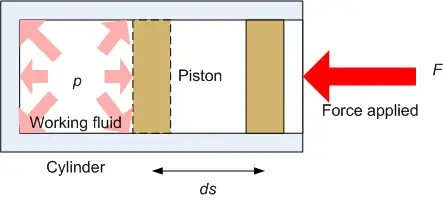
Work input on a working fluid employing a cylinder-piston arrangement (Wiki Image).
Heat engines are one of the most important inventions in human history. They have revolutionized transportation, manufacturing, and many other fields. In the next 50 to 250 years, we can expect even more dramatic advances in heat engine technology.
One of the most promising research areas in heat engine technology is the development of new working fluids. Working fluids are the substances that transfer heat and generate power in a heat engine. New working fluids can increase the efficiency and power of heat engines.
Another promising area of research is the development of new heat engine designs. New heat engine designs can increase heat engines’ efficiency and reliability.
In addition to advances in working fluids and heat engine designs, we can also expect to see advances in heat engine control systems. New heat engine control systems have the potential to improve the performance and reliability of heat engines.
These advances in heat engine technology will have a major impact on how we live and work in the future. Heat engines will continue to be used in various applications, such as transportation, manufacturing, and power generation.
Here are some specific examples of how advances in heat engine technology could be used in the future:
- More efficient power plants: Heat engines generate electricity in power plants. Advances in heat engine technology could lead to more efficient power plants, reducing our reliance on fossil fuels and greenhouse gas emissions.
- More efficient vehicles: Heat engines power cars, trucks, and ships. Advances in heat engine technology could lead to more efficient vehicles, reducing our reliance on fossil fuels and greenhouse gas emissions.
- New applications for heat engines: Heat engines could be used in new applications, such as space exploration and renewable energy systems. For example, heat engines could power spacecraft and generate electricity from solar and geothermal energy.
Overall, the future of heat engine technology is very bright. Advances in heat engine technology can potentially improve the efficiency and reliability of heat engines and lead to new applications for heat engines.
Here are some additional thoughts on the future of heat engine technology:
- Hybrid heat engines: Hybrid heat engines combine the efficiency of a heat engine with the low emissions of an electric motor. Hybrid heat engines could be used in various applications, such as transportation, manufacturing, and power generation.
- Waste heat recovery: Waste heat recovery systems use heat that would otherwise be wasted to generate electricity or to heat buildings. Waste heat recovery systems could be used in various industries, such as manufacturing and power generation.
- Carbon capture and storage (CCS): CCS systems capture carbon dioxide emissions from power plants and other industrial facilities and store them underground. CCS could be used to reduce greenhouse gas emissions from heat engines.
Overall, the future of heat engine technology is very promising. Advances in heat engine technology can make heat engines more efficient, reliable, and environmentally friendly.
AI Laser Invention 2050-2250
Lasers are devices that emit light through a process called stimulated emission. They have a wide range of applications, including manufacturing, medicine, and communication. Here are some of the top potential laser inventions that we can expect to see between 2050 and 2250:
-
Ultrafast lasers: These lasers can emit pulses of light that last for only a few femtoseconds (10^-15 seconds). Ultrafast lasers have a wide range of potential applications, including surgery, manufacturing, and communication.
-
Extreme ultraviolet (EUV) lasers: These lasers emit light in the extreme ultraviolet range of the electromagnetic spectrum. EUV lasers have the potential to be used to manufacture computer chips that are much smaller and faster than current chips.
-
Free-electron lasers (FELs): These lasers use a beam of electrons to produce light. FELs can produce light with a wide range of wavelengths, from X-rays to infrared light. FELs have a wide range of potential applications, including medicine, materials science, and national defense.
-
Mid-infrared (MIR) lasers: These lasers emit light in the mid-infrared range of the electromagnetic spectrum. MIR lasers have the potential to be used to develop new medical treatments, such as laser surgery and laser therapy.
-
Quantum dot lasers: These lasers use quantum dots, which are tiny semiconductor particles, to produce light. Quantum dot lasers have the potential to be more efficient and brighter than current lasers.
These are just a few of the many potential laser inventions that we can expect to see in the coming decades. Lasers have the potential to revolutionize many aspects of our lives, from the way we manufacture products to the way we treat diseases.
I am excited to see how laser technology develops in the coming decades. Lasers have the potential to make the world a better place for everyone.
Here are some specific examples of how new laser inventions could be used:
- Ultrafast lasers could be used to perform surgery without damaging surrounding tissue.
- EUV lasers could be used to manufacture computer chips that are much smaller and faster than current chips.
- FELs could be used to develop new medical treatments, such as laser surgery and laser therapy.
- MIR lasers could be used to develop new medical treatments, such as laser surgery and laser therapy.
- Quantum dot lasers could be used to develop new types of displays and sensors.
I believe that these breakthroughs have the potential to revolutionize many aspects of our lives. By making new discoveries in laser technology, we can improve our health, make our devices more efficient, and even develop new types of products.
However, it is important to use laser technology responsibly and to mitigate any potential risks. For example, we need to be careful not to expose people to harmful levels of laser radiation. We also need to make sure that laser technology is available to everyone, not just the wealthy.
I am optimistic that laser technology can be used to make the world a better place. However, we need to use this technology wisely and carefully.
If you have any other questions, let me know.
AI Lens Invention 2050-2250
Here are some of the top potential lens inventions that we can expect to see between 2050 and 2250:
-
Metamaterial lenses: Metamaterial lenses are lenses that are made of metamaterials, which are materials that have been engineered to have special properties, such as the ability to bend light in ways that are not possible with traditional lenses. Metamaterial lenses have the potential to be used to create much smaller and more powerful lenses than current lenses.
-
Self-focusing lenses: Self-focusing lenses are lenses that can adjust their focus automatically. Self-focusing lenses have the potential to be used to create cameras that can focus on any object, regardless of its distance.
-
Zoom lenses with greater range: Zoom lenses are lenses that can change their focal length, allowing you to zoom in and out on an object. In the future, we can expect to see zoom lenses with a much greater range, allowing you to zoom in on objects that are much farther away.
-
Lenses that can see through objects: Lenses that can see through objects are still in the early stages of development, but they have the potential to be used to create new types of medical imaging devices and security scanners.
-
Lenses that can change color: Lenses that can change color are still in the early stages of development, but they have the potential to be used to create new types of glasses and sunglasses that can change color to match your outfit or the weather.
These are just a few of the many potential lens inventions that we can expect to see in the coming decades. Lenses have the potential to revolutionize many aspects of our lives, from the way we take pictures to the way we see the world.
I am excited to see how lens technology develops in the coming decades. Lenses have the potential to make the world a better place for everyone.
Here are some specific examples of how new lens inventions could be used:
- Metamaterial lenses could be used to create much smaller and more powerful cameras and telescopes.
- Self-focusing lenses could be used to create cameras that can focus on any object, regardless of its distance.
- Zoom lenses with greater range could be used to take pictures of objects that are much farther away, such as wildlife or planets.
- Lenses that can see through objects could be used to create new types of medical imaging devices that can see inside the body without needing to make an incision.
- Lenses that can change color could be used to create new types of glasses and sunglasses that can change color to match your outfit or the weather.
I believe that these breakthroughs have the potential to revolutionize many aspects of our lives. By making new discoveries in lens technology, we can improve our ability to see the world around us and capture images that were never before possible.
However, it is important to use lens technology responsibly and to mitigate any potential risks. For example, we need to be careful not to use lenses to invade people’s privacy. We also need to make sure that lens technology is available to everyone, not just the wealthy.
I am optimistic that lens technology can be used to make the world a better place. However, we need to use this technology wisely and carefully.
If you have any other questions, let me know.
AI Light Invention 2050-2250

LED costume for stage performers (Wiki Images).
Light is a form of electromagnetic radiation visible to the human eye. It is one of the universe’s most important forms of energy and plays a vital role in many biological and physical processes.
In the next 50 to 250 years, we can expect significant advances in our understanding of light and its properties. This will be partly due to new technologies, such as more powerful lasers and sophisticated optical instruments.
One of the most promising areas of research in light science is the development of new light sources. New light sources with higher brightness, shorter pulses, and more precise control could revolutionize many fields, including medicine, materials science, and communication.
Another promising area of research is the development of new light-manipulating materials. New light-manipulating materials could create new devices, such as invisibility cloaks and teleportation devices.
In addition to advances in our understanding of light and its properties, we can also expect to see new applications of light in many fields. For example, light could be used to develop new medical treatments, to create new materials with unique properties, and to develop new communication technologies.
Here are some examples of how advances in light science could be used in the future:
- New medical treatments: Light could be used to develop new medical treatments, such as laser surgery and photodynamic therapy. These treatments could be used to treat various diseases, including cancer, heart disease, and blindness.
- New materials with unique properties: Light could be used to create new materials with unique properties, such as superconductors and materials that are invisible to light. These materials could have various applications, including electronics, energy, and national security.
- New communication technologies: Light could be used to develop new communication technologies, such as optical fiber communication and LiDAR. These technologies could provide faster and more secure communication than current technologies.
- Fusion power: Fusion power is a clean and sustainable source of energy that has the potential to revolutionize the world. It could provide a virtually limitless source of energy for humanity.
Overall, the future of light science is very bright. Advances in light science have the potential to revolutionize many fields and improve our lives in many ways.
Here are some additional thoughts on the future of light science:
- Quantum light: Quantum light is a new type with some strange properties. For example, quantum light can be used to teleport information. Quantum light is still in its early stages of development, but it has the potential to revolutionize many fields, including communication and computing.
- Metamaterials: Metamaterials are materials that have been engineered to have properties that are not found in nature. For example, metamaterials can create lenses that bend light in new ways. Metamaterials are still in their early stages of development, but they can potentially revolutionize many fields, including optics and communication.
Overall, the future of light science is very promising. Advances in light science have the potential to revolutionize many fields and improve our lives in many ways.
AI Machine Learning Invention 2050-2250

Machine learning (Wiki Image).
Machine learning (ML) is an artificial intelligence (AI) that allows software applications to learn and improve from experience without being explicitly programmed. ML is used in various applications, including fraud detection, medical diagnosis, and product recommendation.
In the next 50 to 250 years, we expect to see even more advances in ML. ML algorithms will become more sophisticated and efficient, and they will be able to solve more complex problems. ML will also be used in new and innovative ways.
One of the most promising areas of ML research is deep learning. Deep learning algorithms can learn from large amounts of data without being explicitly programmed. Deep learning is already used in various applications, such as image recognition and natural language processing. In the future, we can expect to see deep learning algorithms used in even more applications, such as self-driving cars and medical diagnosis.
Another promising area of ML research is reinforcement learning. By trial and error, reinforcement learning algorithms can learn how to behave in an environment. Reinforcement learning algorithms are already used in various applications, such as game-playing and robotics. In the future, we can expect reinforcement learning algorithms to be used in even more applications, such as self-driving cars and industrial automation.
Overall, the future of ML is very bright. ML is a powerful tool that can solve a wide range of problems. In the next 50 to 250 years, we can expect to see even more advances in the field of ML and new applications for ML will be found.
Here are some specific examples of how ML could be used in the future:
- Develop new drugs and therapies: ML could be used to develop new drugs and therapies that are more targeted and effective than current treatments. For example, ML could be used to design drugs specifically targeting cancer cells.
- Develop new materials: ML could develop new materials with improved properties, such as strength, durability, and lightness. For example, ML could be used to design new materials for construction and aerospace.
- Improve financial markets: ML could be used to develop new financial models that are more accurate and reliable than current models. This could reduce risk and improve efficiency in the financial markets.
- Create new forms of art and entertainment: ML could be used to create new forms. For example, ML could create new video games and movies with more realistic and immersive graphics.
Overall, ML is a powerful tool that can solve many problems. In the next 50 to 250 years, we can expect to see even more advances in the field of ML and new applications for ML will be found.
AI Magnetic Invention 2050-2250
Magnets are devices that produce a magnetic field. They have a wide range of applications, including manufacturing, medicine, and transportation. Here are some of the top potential magnetic inventions that we can expect to see between 2050 and 2250:
-
Superconducting magnets: Superconducting magnets are magnets that can produce very strong magnetic fields without using any electricity. Superconducting magnets have a wide range of potential applications, including magnetic levitation (maglev) trains, magnetic resonance imaging (MRI) machines, and nuclear fusion reactors.
-
Spintronics: Spintronics is a field of electronics that uses the spin of electrons to create new types of electronic devices. Spintronics has the potential to revolutionize many aspects of electronics, including computers, smartphones, and sensors.
-
Magnetic refrigeration: Magnetic refrigeration is a type of refrigeration that uses magnets to cool objects. Magnetic refrigeration has the potential to be more efficient and environmentally friendly than current refrigeration methods.
-
Magnetic levitation (maglev) transportation: Maglev trains use magnets to levitate and propel trains above tracks. Maglev trains have the potential to be much faster and more efficient than current trains.
-
Magnetically controlled nanobots: Magnetically controlled nanobots are tiny robots that can be controlled using magnets. Nanobots have the potential to be used to deliver drugs directly to diseased cells, clean up pollutants, and even perform surgery.
These are just a few of the many potential magnetic inventions that we can expect to see in the coming decades. Magnets have the potential to revolutionize many aspects of our lives, from the way we travel to the way we treat diseases.
I am excited to see how magnetic technology develops in the coming decades. Magnets have the potential to make the world a better place for everyone.
Here are some specific examples of how new magnetic inventions could be used:
- Superconducting magnets could be used to create maglev trains that travel at speeds of over 300 miles per hour.
- Spintronics could be used to create computers that are much faster and more energy-efficient than current computers.
- Magnetic refrigeration could be used to create refrigerators that are more efficient and environmentally friendly than current refrigerators.
- Maglev trains could be used to create a new type of transportation system that is faster, more efficient, and more environmentally friendly than current transportation systems.
- Magnetically controlled nanobots could be used to deliver drugs directly to diseased cells, clean up pollutants, and even perform surgery.
I believe these breakthroughs can potentially revolutionize many aspects of our lives. By making new discoveries in magnetic technology, we can improve our transportation systems, make our devices more efficient, and even develop new medical treatments.
However, using magnetic technology responsibly and mitigating any potential risks is important. For example, we need to be careful not to expose people to harmful levels of magnetic radiation. We also need to make sure that magnetic technology is available to everyone, not just the wealthy.
I am optimistic that magnetic technology can be used to make the world a better place. However, we need to use this technology wisely and carefully.
If you have any other questions, let me know.
AI Marketing Invention 2050-2250
Sure, here are some of the top potential inventions in marketing between 2050 and 2250:
-
Fully immersive virtual reality (VR) marketing: Fully immersive VR marketing will allow businesses to create interactive experiences transporting customers into their products and services. Imagine test-driving a car without leaving your living room or trying a new outfit without ever setting foot in a store. This technology could revolutionize the way businesses interact with their customers.
Fully immersive virtual reality (VR) marketing -
Thought-controlled marketing: Thought-controlled marketing will allow businesses to target their advertising based on people’s thoughts and emotions. Imagine being able to walk into a store and have the products you need appear in front of you without having to search for them. This technology could transform the way businesses sell their products and services.
Thoughtcontrolled marketing -
Real-time customer feedback: Real-time customer feedback will allow businesses to track their customers’ reactions to their products and services in real-time. Imagine being able to see how people are responding to a new ad campaign or product launch the moment it happens. This technology could help businesses make better decisions about their products and services.
Realtime customer feedback -
AI-powered marketing automation: AI-powered marketing automation will allow businesses to automate many of their marketing tasks, such as creating content, targeting ads, and tracking customer behavior. Imagine being able to create a marketing campaign that runs itself from start to finish. This technology could save businesses time and money and help them to reach more customers.
AIpowered marketing automation -
Predictive analytics: Predictive analytics will allow businesses to use data to predict future customer behavior. Imagine being able to predict who is most likely to buy a product or service and then target them with personalized marketing messages. This technology could help businesses increase their sales and profits.
Predictive analytics
These are just a few of the many potential inventions in marketing between 2050 and 2250. These inventions have the potential to revolutionize the way businesses interact with their customers and make the world a better place by connecting people with products and services that they need and want.
However, using marketing technology responsibly and mitigating any potential risks is important. For example, we need to be careful not to use technology to manipulate people or to invade their privacy. We also need to ensure that marketing technology is available to everyone, not just the wealthy. I am optimistic that marketing technology can be used to make the world a better place. However, we need to use this technology wisely and carefully.
If you have any other questions or requests, let me know.
AI Math Invention 2050-2250
Here are some of the top potential AI inventions in mathematics between 2050 and 2250:
-
Automatic Theorem Proving (ATP): ATP is the field of computer science that deals with the automation of mathematical proofs. ATP systems have the potential to prove large and complex theorems that would be impossible or impractical for humans to prove by hand.
-
Machine Learning (ML) for Mathematics: ML is a field of computer science that allows computers to learn from data without being explicitly programmed. ML has the potential to be used to solve a wide range of mathematical problems, including classification, regression, and optimization.
-
Symbolic and numerical computation: Symbolic and numerical computation are two different approaches to solving mathematical problems. Symbolic computation involves manipulating mathematical expressions in a symbolic form, while numerical computation involves approximating solutions to mathematical problems using numerical methods. AI has the potential to revolutionize both symbolic and numerical computation by developing new algorithms and techniques that are more efficient and powerful than current methods.
-
Math education: AI has the potential to revolutionize math education by providing personalized instruction and feedback to students. AI-powered tutors can adapt to the individual needs of each student and provide them with the support they need to succeed.
-
Real-world applications of mathematics: AI has the potential to revolutionize many real-world applications of mathematics, such as engineering, finance, and medicine. AI can be used to solve complex mathematical problems that are too difficult or time-consuming for humans to solve by hand.
These are just a few of the many potential AI inventions in mathematics between 2050 and 2250. AI has the potential to revolutionize many aspects of mathematics, from the way we prove theorems to the way we apply mathematics to real-world problems.
I am excited to see how AI technology develops in the coming decades. AI has the potential to make the world a better place for everyone by improving our understanding of mathematics and its applications.
Here are some specific examples of how new AI inventions in mathematics could be used:
- ATP systems could be used to prove large and complex theorems that would be impossible or impractical for humans to prove by hand.
- ML could be used to solve a wide range of mathematical problems, including classification, regression, and optimization.
- New algorithms and techniques for symbolic and numerical computation that are more efficient and powerful than current methods could be developed.
- AI-powered tutors could be used to provide personalized instruction and feedback to students.
- AI could be used to solve complex mathematical problems in engineering, finance, and medicine.
I believe that these breakthroughs have the potential to revolutionize many aspects of mathematics. By making new discoveries in AI, we can improve our understanding of mathematics and its applications.
However, it is important to use AI technology responsibly and to mitigate any potential risks. For example, we need to be careful not to let AI make decisions that could harm humans. We also need to make sure that AI is available to everyone, not just the wealthy.
I am optimistic that AI can be used to make the world a better place. However, we need to use this technology wisely and carefully.
AI Microscope Invention 2050-2250
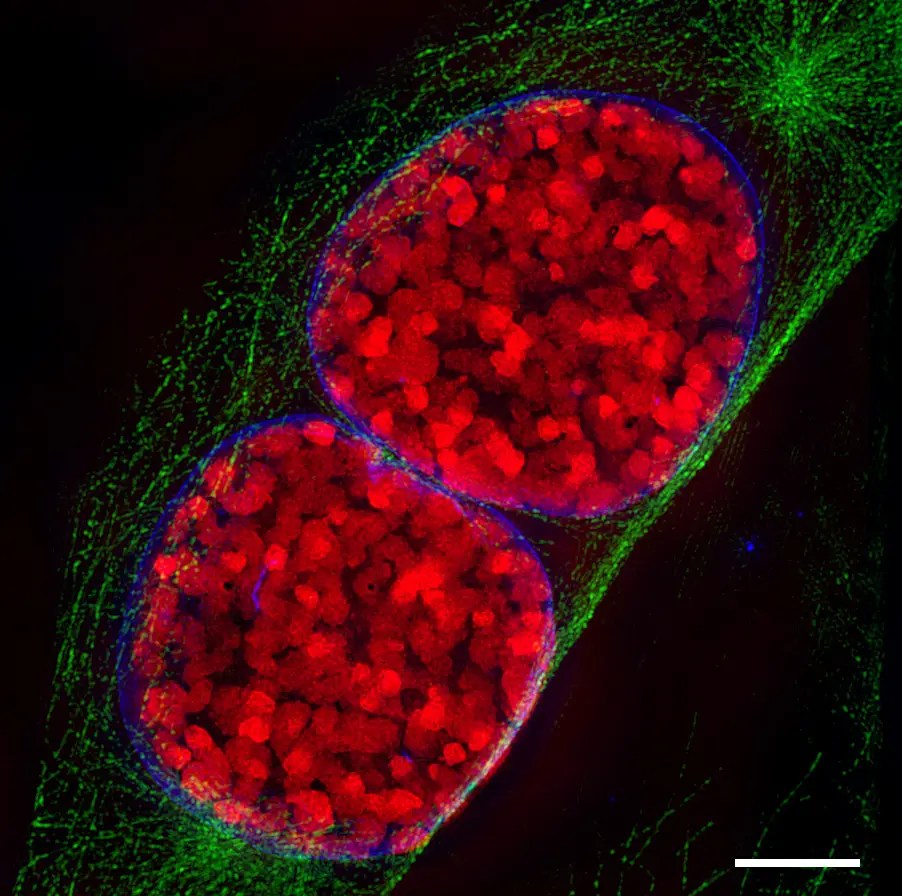
Two mouse cell nuclei in prophase (Wiki Image).
The microscope is one of the most important inventions in human history. It has allowed us to see the world differently and has revolutionized many fields, including biology, medicine, and materials science.
Microscope technology is constantly evolving, and new microscopes are always being developed. In the next 50 to 250 years, we expect even more dramatic advances in microscope technology.
One of the most promising areas of microscope research is super-resolution microscopy. Super-resolution microscopes can overcome the diffraction limit of conventional microscopes and achieve up to 100 times higher resolutions. This means that super-resolution microscopes can be used to visualize objects that are too small to be seen with traditional microscopes.
Another promising area of microscope research is nanoscopy. Nanoscopes can be used to image objects that are only a few nanometers in size. This makes them ideal for studying individual molecules and atoms.
In the future, we can expect microscopes that are even more powerful and versatile than today’s. These microscopes will be able to image objects with unprecedented resolution and speed. They can also image objects in different environments, such as inside living cells and the body.
Here are some specific examples of how microscopes could be used in the future:
- Medical diagnosis and treatment: Microscopes could be used to develop new, more accurate disease diagnostic tools. They could also be used to develop new treatments for diseases such as cancer and Alzheimer’s disease.
- Materials science: Microscopes could develop new materials with improved properties, such as strength, durability, and lightness.
- Nanotechnology: Microscopes could be used to develop new nanodevices for various applications, such as drug delivery and electronics.
- Space exploration: Microscopes could be used to study extraterrestrial life and develop new space exploration materials.
Overall, the future of microscopy is very bright. Microscopes are becoming increasingly powerful and versatile and used to make new discoveries in various fields.
AI Mining Invention 2050-2250
Mining is a crucial industry that extracts valuable minerals and resources from the Earth’s crust. As technology advances, we can expect to see innovative inventions that revolutionize the mining industry between 2050 and 2250. Here are some of the top potential mining inventions that we can expect to see in the future:
-
Autonomous mining vehicles: Autonomous mining vehicles, such as trucks and excavators, are controlled by computers and sensors, eliminating the need for human operators. These vehicles can work 24/7 without breaks, increasing productivity and reducing safety risks.
-
Underground mining robotics: Robots are becoming increasingly sophisticated, allowing them to perform complex tasks in underground mines. These robots can perform tasks like drilling, blasting, and hauling, reducing the need for human workers in hazardous environments.
-
Artificial intelligence (AI) for mineral exploration: AI can analyze vast amounts of geological data to identify potential mineral deposits, saving time and money for exploration companies. AI can also be used to optimize mining operations, improving efficiency and reducing waste.
-
Sustainable mining practices: The mining industry is under increasing pressure to adopt sustainable practices. New technologies are being developed to reduce the environmental impact of mining, such as waterless processing and renewable energy sources.
-
Space mining: As technology advances, space mining is becoming a more realistic possibility. In the future, we may be able to extract minerals from asteroids and other celestial bodies, providing a new source of resources for Earth.
These are just a few of the many potential mining inventions that we can expect to see in the coming decades. Mining technology is constantly evolving, and these inventions have the potential to revolutionize the industry, making it safer, more efficient, and more sustainable.
I am excited to see how mining technology develops in the coming decades. These inventions have the potential to make the world a better place by providing a more sustainable source of minerals and resources.
Here are some specific examples of how new mining inventions could be used:
- Autonomous mining vehicles could work 24/7 without breaks, increasing productivity and reducing safety risks.
- Underground mining robots could perform hazardous tasks, reducing the need for human workers in dangerous environments.
- AI could identify potential mineral deposits, saving time and money for exploration companies.
- Sustainable mining practices could reduce the environmental impact of mining.
- Space mining could provide a new source of minerals and resources for Earth.
I believe that these breakthroughs have the potential to revolutionize the mining industry. By making new discoveries in mining technology, we can improve safety, increase efficiency, and reduce the environmental impact of mining.
However, it is important to use mining technology responsibly and to mitigate any potential risks. For example, we need to be careful not to damage the environment or displace communities. We also need to make sure that mining technology is available to everyone, not just the wealthy.
I am optimistic that mining technology can be used to make the world a better place. However, we need to use this technology wisely and carefully.
AI Molecular Manufacturing Invention 2050-2250
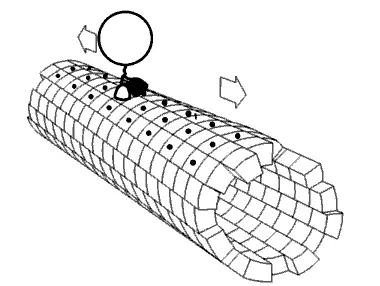
Kinesin is a protein complex functioning as a molecular biological machine. It uses protein domain dynamics on nanoscales (Wiki Images).
Molecular manufacturing (MM) is a hypothetical process by which machines build objects one molecule at a time. It is a type of nanotechnology that has the potential to revolutionize many industries, including manufacturing, medicine, and energy.
MM machines could be used to create products with unprecedented precision and accuracy. They could also be used to create new materials with unique properties. For example, MM machines could be used to create materials that are stronger, lighter, and more durable than existing materials.
MM could also have a major impact on the medical industry. MM machines could create new drugs and therapies that are more targeted and effective than current treatments. MM machines could also create new medical devices like artificial organs and implants.
In addition, MM could help us to transition to a more sustainable future. MM machines could create new energy sources and energy storage devices. MM machines could also be used to develop new ways to recycle and reuse materials.
MM is still a theoretical concept, but significant progress has occurred recently. Researchers have developed new techniques for manipulating molecules and atoms and created prototypes of simple MM machines.
It is difficult to say when MM will be fully commercialized, but it can have a major impact on the world in the coming decades.
Here are some potential benefits of MM:
- Improved product quality: MM machines could create products with unprecedented precision and accuracy. This could lead to improvements in the quality of products in a wide range of industries, including manufacturing, medicine, and electronics.
- New materials: MM machines could create new materials with unique properties. For example, MM machines could be used to create materials that are stronger, lighter, and more durable than existing materials.
- New medical treatments: MM machines could create new drugs and therapies that are more targeted and effective than current treatments. MM machines could also create new medical devices like artificial organs and implants.
- A more sustainable future: MM machines could help us transition to a more sustainable future. MM machines could create new energy sources and energy storage devices. MM machines could also be used to develop new ways to recycle and reuse materials.
Here are some challenges that must be overcome before MM can be fully commercialized:
- Technical challenges: Many technical challenges must be overcome before MM can be fully commercialized. For example, researchers need to develop ways to control the assembly of molecules precisely and to create MM machines that are efficient and cost-effective.
- Safety concerns: There are some safety concerns associated with MM. For example, there is a risk that MM machines could be used to create dangerous or harmful products.
- Social acceptance: MM is a new technology, and there may be some social resistance. For example, some people may be concerned about the potential for MM to be used to create designer babies or to create new forms of weapons.
Despite these challenges, the potential benefits of MM are vast. MM has the potential to revolutionize many industries and improve the quality of life for people worldwide.
Here are some examples of how MM could be used in the future:
- Manufacturing: MM machines could create products with unprecedented precision and accuracy. This could lead to improvements in the quality of products in a wide range of industries, including manufacturing, medicine, and electronics. For example, MM machines could be used to create computer chips that are smaller and more powerful than current chips. MM machines could also be used to create new types of medical devices, such as artificial hearts and kidneys.
- Medicine: MM machines could create new drugs and therapies more targeted and effective than current treatments. For example, MM machines could create drugs specifically targeting cancer cells. MM machines could also create new medical devices like artificial organs and implants.
- Energy: MM machines could help us to develop new and more efficient energy sources. For example, MM machines could create new types of solar cells and batteries. MM machines could also be used to develop new ways to extract energy from fossil fuels and other resources.
- Environmental protection: MM machines could help us reduce pollution and clean up the environment. For example, MM machines could be used to develop new ways to filter water and air. MM machines could also be used to develop new ways to recycle and reuse materials.
MM is a powerful technology with the potential to revolutionize many industries and improve the quality of life for people worldwide.

